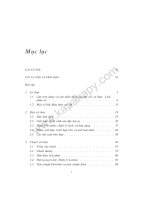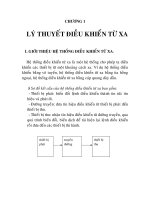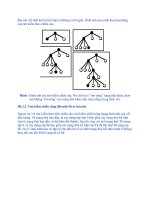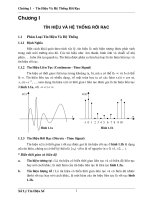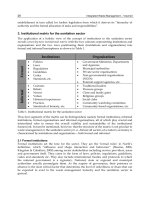i\ARANEAE Vol. I Part 1 THOMISIDAE ( CRABSPIDERS) By B. K. TIKADER, Ph.D., D.Sc. Zoological Survey of India Part 2 LYCOSIDAE ( WOLFSPIDERS) By B. K. TIKADER, Ph.D., D.Se. Zoologieal Survey of India
Bạn đang xem bản rút gọn của tài liệu. Xem và tải ngay bản đầy đủ của tài liệu tại đây (14.27 MB, 465 trang )
THE FAUNA OF INDIA
ARANEAE
Vol. I
Part 1
THOMISIDAE
( CRAB-SPIDERS)
By
B. K. TIKADER, Ph.D., D.Sc.
Zoological Survey of India
Part 2
LYCOSIDAE
( WOLF-SPIDERS)
By
B. K. TIKADER, Ph.D., D.Se.
Zoologieal Survey of India
AND
M. S. MALHOTRA, Ph.D.
Issued by the Zoological Survey of India, Calcutta. Published by
the Manager of Publications, Government of India, Delhi.
Printed in India by Sangam Press Pvt. Ltd., Poona 29.
1980
© COPYRIGHT, 1980, GOVERNMENT OF INDIA.
Published in April, 1980
Price : India : Rs. 100/00
Foreign £ 10/- or S 20/00
1.
C,a'lnariCU8 jorntO,8U8 Thorell (M,a le).
EDITOR'S PREFACE
Arter independence the responsibility for pUblication of "Fauna
of British India" passed on from the Secretary of State for India
(to the British Government) to the Government of India and the
Director, Zoological Survey of India, was entrusted with the task
of editing the series. In keeping with the changed political setup
after August 1947, the title of the series was changed to "Fauna
of India" It was also decided to select authors for this prestigious
series of Zoological publication from amongst reputed specialists
on diverse groups of animals available in India, as far as possible.
Under the new setup nine volumes have already been published
dealing with Rodents (Mammalia), Butterflies, Coleoptera, Muscidae (Diptera), Gryllids, Polychaeta and Fishes and several others
are in press, or in preparation. The present volume on "Spiders"
by Dr. B. K. Tikader, Joint Director, Zoological Survey of India
and a specialist on Indian Spiders, is the tenth to appear under
the new setup.
Spiders are among the most ubiquitous arthropods that are too
conspicuous to escape notice, and the Indian subcontinent has a
large diversity of spider fauna rich in variety as weJl as abundance.
Yet after Pocock's (1900) work on Arachnida no consolidated
account of Indian Spiders is available. During this period considerable addition has been made to the knowledge of Indian spiders
and it was considered necessary to bring all available information
together.
The present volume is divided into two parts. The first part by
Dr. B. K.Tikader deals with 115 Indian species of the family Thomisidae comprising of what are popularly known as crab-spiders.
The second part, containing 81 species of the family Lycosidae is
written jointly by Dr. Tikader and Dr. M. S. Malhotra.
It has been our endeavour to maintain uniformity of treatment
of the subject matter in different volumes of the fauna, but this
has not been always possible. In some groups of animals as in the
case of Indian Spiders there is considerable kno\vledge gap on
"
11
aspects of Zoogeography, phylogenetic relationships etc., and the
authors did not find it possible to cover these aspects for want of
necessary information. It is hoped that the present work will
provide a handy tool to specialists and research students in India
and elsewhere in the study of Indian spiders.
T
Calcutta
30th April, 1980
N. ANANTHAKRISHNAN
Director
Zoological Survey of India
AUTHOR'S PREFACE
The crab-spiders which comprise the family Thomisidae are very
common and abundant in our country but have received little
attention by the taxonomists. The typical members have a peculiar crab-like appearance. The first two pairs of legs are long and
stout and frequently rno ve sideways as in a crab.
Pocock (1900) in his "Fauna of British India Arachnida," volume
has dealt with spiders which are common and conspicuous.
Apart from Scorpions, Uropygi, Amblypygi, Solifugae he recorded
about two hundred species of spiders from India, Burma and
Sri Lanka. Many common and well kno\vn families like Thomisidae
were not reported from India.
The present volume deals with one hundred and fifteen species,
contained in twenty-five genera of the family Thomisidae. Of these,
twenty-three species are new to science. A detailed account of
morphology of spiders, characters of taxonomic importance,
habitat, food and feeding habit~ and a list of families and higher
categories has been given. As far as possible keys for identification of genera and species of the family Thomisidae as \vell
as the diagrams for each species have been provided.
I wish to take this opportunity to express my grateful thanks to
my colleagues in the Zoological Survey of India and Dr. B. H.
Patel, Professor and Head of the department of Z oo)ogy, Sir, P. P.
Institute of Science, Bhavnagar, Gujarat; Dr. Manoranjan Barman,
Head of the Dept. of Zoology, Lady Keane College, Shillong,
Meghalaya; Shri K. D. Ghorpade,' C.S.I.R. Research fellow,
University of Agricultural Science, Bangalore., who have rendered
the work possible by lending or collecting specimens for my
study.
My thanks are due to Dr. T N. Ananthakrishnan, Director ~
Zoological Survey of India for encouragement and offering me
useful suggestions during the preparation of this volume and
TIKADER : FAUNA OF INDIA : ARANEAE : SPIDER
for placing the valuable types, named and unnamed thomisid
spiders collection of Zoological Survey of India, Calcutta, at my
disposal. My deepest appreciation for the invaluable aid and
encouragement which was primarily responsible for initiating
a detailed study on this interesting group of animals goes especially to Dr. M. S. Mani, former Deputy Director, Zoological
Survey of India, Calcutta.
I am thankful to Shri G. Sivagurunathan, Publication Production Offlicer and Dr. A. K. Ghosh, Superentending Zoologist,
Fauna Unit, Zoological Survey of India, Calcutta for assisting in
various ways for quick publication of this volume.
Thanks are due to Dr. M. Babu Rao, Dr. R. H. Kamble,
Dr. M. S. Malhotra, Dr. U. A. Gajbe and Dr. Bijan Biswas
of Zoological Survey (of India, Western Regional Station, Poona
and Calcutta, for assisting in various ways during the preparation of the manuscript. I am also indebted to Shri S. K. Ch~.nda
and Shri P. W. Garde, Artists of Zoological Survey of India,
Western Regional Station, for preparation of illustrations and to
Shri K. H. Valecha, Stenographer, for typing the manuscript.
Lastly I would like to express my grateful thanks to th e
Department of Science and Technology, Government of India,
for honouring me by assigning the writing up of fauna volumes
on spiders.
POONA
30th April, 1980.
Buddha Purnima.
B. K. TIKADER
CONTENTS
PAGE
TAXONOMIC CHARACTERS OF SPIDERS
MORPHOMETRIC MEASUREMENTS
11
HABITAT, FOOD AND FEEDING HABITS
11
FAMILIES AND HIGHER CATEGORIES OF SPIDERS
16
KEY TO THE FAMILIES OF INDIAN SPIDERS
19
FAMILY THOMISIDAE
26
SUB·FAMILY MISUMENINAE (Mi-su-me-ni-nae)
27
KEY TO GENERA OF THE SUB-FAMILY MISUMENINAE
29
Genus 1.
Tho/nisus Walckenaer
Key to species of the genus THOMISUS Walck ..
30
30
31
1.
Tho/nisus sikkilnensis Tikader
2.
T.
shivujiellsis Tikader
33
3.
T.
poonellS Tikader
35
36
4. T. loboslls Tikader
5
T.
katrajghaills Tikader
38
6.
T.
andanJanellsis sp. nov.
39
7.
T.
projecilis Tikader
40
8. T. dhakllriensis Tikader
41
Ba~u
43
9. T. /nemae Sen and
10.
T.
rishus Tikader
45
11.
T.
sorajaii BaC)u
46
12.
T.
pilgi/is Stoliczka
48
13.
T.
bllla"i Tikader
50
14.
T.
s/til/ongellsis Sen
51
15.
T.
beallii/ularis Basu
52
16.
T.
cherapunjeus Tikader
5~
17.
T.
e/ollgallis Sto]jczka
56
·.
CONTENTS
11
PAGE
Genus 2.
Runcinia Simon
Key to species of the genus RUNCINIA Simon.
58
58
18.
RUllc;nia escheri Reimoser
59
19.
R. chauhani Sen and Basu
60
20.
R.
21.
R. ghorpadei sp. nov.
Genus 3.
roonwali Tikader
Pistius Simon
Key to species of the genus PISTIUS Simon
62
64
65
66
22.
Pislius bhadurii Basu
23.
P.
gangulyi Basu
68
24.
P.
robusla Basu
70
25.
P.
sreepanchamii Tikader
71
26.
P.
kanikae Basu
73
27.
P.
kalimpus Tikader
74
28.
P.
barc/zensis Basu
76
29.
P. roonwali Basu
Genus 4.
Oxyplila Simon
Key to species of the genus 0 XYPTILA Simon
66
78
79
80
30.
Oxyptila klzas; Tikader
80
31.
O. Inanii Tikader
82
32.
O.
reenae Basu
83
33.
O.
Inaralha (Tikader)
85
34.
O.
an1khasensis sp. nov.
86
35.
O.
challdosiens;s sp. nov.
88
Genus 5.
Misulnena Latreille
Key to specie.> of the genus MISUMENA Latreille
90
90
36.
Misulnena menoka Tikader
37.
M.
hora; Tikader
93
38.
M.
nlridula; Tikader
94
39.
M.
indra Tikader
95
40. M. silvery; Tikader
91
97
CONTENTS
...
111
PAGE
41. M. annapurna Tikader
98
42.
M.
greellae Tikader
100
43.
M.
Ilicobarellsis sp. nov.
102
44.
M.
decorata sp. nov.
103
Genus 6.
45.
Diaea Thorell
105
Diaea jailltious Tikader
Genus 7.
105
107
Xysticus Koch
Key to species of the genus XYSTICUS Koch
108
46.
Xysticus kalnakhyai Tikader
109
47.
X.
hilldusthanicus Basu.
III
48.
X.
roollwali Tikader
112
49'
X.
shyanlrupus Tikader
J J3
50.
X.
sikkil111IS Tikader
115
51.
X.
kaslridi Tikader
116
52.
X.
nlandali Tikader
11 ~
53.
X.
lJlillutus Tikadel'
120
54.
X.
sujatai Tikader
121
55.
X. pynurus Tikader
123
56.
X. jayantius Tikader
124
57.
X.
shillongellsis Tikader
126
58.
X.
bengalensis Tikader & Biswa,
127
59.
X.
himalayaensis Tikader & Biswas
129
60.
X.
kali Tikader &
61.
X.
khasiensis sp. nov.
132
Synaenlu Simon
134
Genus 8.
Biswa~
Key to species of the genus SYNAEMA Simon
130
134
62.
Synael11a brunettU Tikader
134
63.
S.
decorata Tikader
136
64.
S.
nlysorensis sp. nov.
138
CONTENTS
IV
PAGE
Genus 9.
B0l11is Koch
139
65.
B0l11is bellgalensis Tikader
140
140
66.
B.
khajuriai sp. nov.
141
MOllaeses Thorell
143
Key to species of the genus BOMIS Koch
Genus 10.
Key to species of the genus MONAESES Thoren
mukundi sp. nov.
144
145
T,narus Simon
147
67.
MOllaeses parvati Tikader
68.
M.
Genus 11.
143
69.
T,narus kotig(;harlls Tikader
147
147
70:
T.
pachpedielisis sp nov ..
149
Key to species of the genus TMARUS Simon
Genus 12.
Misul11enoides Cambridge
Key to species of the genus MISUMENOIDES Cambridge
150
150
151
71.
Misll111elloides kripolaniae Tikader
72.
M.
deccanes Tikader
152
73.
M.
shulli Tikader
154
Misul11enOpS Cambridge
156
Genus 13.
Key to specie3 of the: genus MISUM£NOPS Cambridge
156
156
74.
MisuI11enOpS khalldalaellsis Tikader
75.
M.
kumaonensis sp. nov.
157
76.
M.
GIld0l11anensis sp. nov.
159
Genus 14. Pasias Simon
161
Key to species of the genus PASIAS Simon
161
161
77.
Pasias puspagiri Tikader
78.
P.
I1larathas Tikader
163
Genus 15.
Strigoplus Simon
164
Strigopills netravati Tikader
165
79.
Genus 16.
80.
RegUlus Cambridge.
Regillus elephantus Tikader
166
167
CONTENTS
v
PAGE
Genus 17.
81.
Anzyciaea Simon
Amyciaea forticeps (Cambridge)
168
169
Gellus 18. P!atythonlisus Doles4,;·h.
170
Key to species of the genus PLATYTHOMISUS Dolesch.
171
82. Platythomisus bazarlls Tikader
83.
P.
sudeepi Biswas
171
172
Genus 19. Camaricus Thorell
174
Key to species of the genus CAMARICUS Thorell
174
84.
Camaricus formosus Thorell
85.
C.
khondalaensis sp. nov.
175
176
SUB-FAMILY PHILODROMINAE (Phil-od-ro-minae).
178
KEY TO GENERA OF THE SUB-FAMILY PHILODROMINAE
178
Genus 20. Ebo Koyserling
179
Ebo bharalae Tikader
179
Genus 21. Philodromlls Walckenaer
181
Key to species of the genus PHILODROMUS Walck.
181
86.
87. Philodromlls domesticus Tikader
183
88.
assamensis Tikader
185
89. P.
betrabata; Tikader
187
90. P.
shil/ongensis Tikadel'
189
91. P.
kendrabatai Tikadfr.
191
P.
devhutai Tikader
193
93. P.
mall;kae Tikader
195
94. P.
decoratusTikader
196
95. P.
mohiniae Tikader
198
96. P.
bhagirathai Tikader
200
97. P.
maliniae Tikader
202
92.
P.
98
P.
durvei sp. nov.
204
99.
P.
chambaens;s sp. nov.
206
100.
P.
bannan; sp. nov.
108
101.
P.
tiwarU Basu
211
CONTENTS
Vi
PAGE
Genus 22.
213
Tibellus Simon
Key to species of the genus TIBELL US Simon
102.
Tibellus chaturshing; Tikader
103.
T.
poonaensis Tikader
104.
T.
elollgatus Tikader
105.
T. pashanensis sp. nov.
lU6.
T
10?
T. pateli sp. nov.
Genus 23.
213
214
215
211
219
katrajghatlls Tikader
220
222
224
Thanatus Koch
Key to species of the genus THANATUS Koch
224
108.
Thanatus lanclolatus Tikader
225
109.
T.
dhakuricus Tikader
226
110.
T.
nlandali Tikader
228
111.
T.
stripatus sp. nov.
229
Genu~
112.
24. Apollophanes Cambridge
Apol/ophanes
Genus 25.
bang%~~res
Tikader
Dieta Simon
Key to species of the genus DIETA Simon
231
231
233
233
113.
Dieta elongata sp. nov.
234
114.
D. greenae sp. nov.
235
115.
D.
kapl,ri sp. nov.
237
BIBLIOGRAPHY
241
ALPHABETICAL INDEX
245
TAXONOMIC CHARACTERS OF SPIDERS
(Figs. 3-18)
The body of a spider is divisible into a distinctive cephalothorax and abdomen, joined together by a narrow pedicel. The
cephalothorax is covered dorsally gy a hard sclerotic shield, the
carapace, and ventrally by the sternum. The anterior margin of
the sternum articulates movably with the labiuln. With fe'~ exceptions, in most of the spiders, there is a deep transverse groove,
forming a kind of hinge, between the sternum and the labium.
The legs are articulated in the pl~ural membrane that lies between
:. -'.'" ·····fang
...·...·-·-.chelicera
• -~~ . -···--carapace
"",/ .... --cervIcal groove l/)
0'):"
.. ~.: ."1.:-::::.. _... .tho~acic groove ~ i
..'\ "..- .. ·· ....···radlal furrow
0;
.:. . ······pedicel
QJl
\ . _- ___ -thoracic region ~ L
o
U
.......... ···cardiac area
....-...._. ·.. -abdomen dorsal
i
r' scopula of maxilla
-: 0
3
maxilla
•
·· .... ··(ablum
•.......
.
.,..... ··5 ternum
..
.' ... " .. _....anal tubercle
"""
! ....... anterior spinnerets ....... __ '" (':~::\. ':.:......... abdomen vent ral
: ..··.. ··posterior spinnerets .. ··_....·:·
·........ ·cribellum
L. .........median spinnerets ........ _.. :... !
L.
eyes area pedicel epigastric furrow
':
i
.
,
:
,"I~-~
clypeus.-............... . ,
boss ........_......... _.
chelicera .......... ..
.anal tubercle
.post. spinnerets
. : :..med. spinnerets
I
.
I
t ......... '! ............... .
5
FIG.
FIG.
FIG.
3.
4.
5.
carapace
.., .. ' .........~ ...... _..... _...... ' j
L... ant. spinnerets
abdomen
Dorsal view of a typical spider, legs omitted.
Ventral view of a typical spider, legs omitted.
Lateral view of a typical spider, legs omitted.
2
TIKADER : FAUNA OF INDIA : ARANEAE : SPIDER
the lateral edges of the carapace and sternum. On the cephalothorax we may distinguish an anterior cephalic region and a posterior thoracic region separated by a thoracic groove on the dorsum.
On the cephalic region are situated six to eight simple eyes. The
eyes are generally of two kinds, viz., black or diurnal and white
or nocturnal eyes. When only one type is present, the condition
is described as homogeneous, in contradistinction to the heterogeneous condition, where both the types are present. The eyes
c.
are usually arranged in two rows viz., the anterior row and the
pO"S~r{'lr row. Each row usually contains four eyes. The eye row
is described as, recurved, when the concavity is turned backwards.
According to their position, the eyes are described as the anterior
medians, the posterior medians, .the anterior laterals a.nd the
posterior laterals. The cephalic area, occupied by the eyes is known
as the ocular area. The area of the four median eyes is termed
the ocular quad. The area between the anterior row of eyes and
the base of chelicerae is the clypeus. The space between the
anterior median eyes and the nlargin of clypeus represents the
width of clypeus. There is often a depression in the middle of the
thorax, called the thoracic groove. A convex, lens like, black or
deep brown mark called the fovea replaces the thoracic groove In
the family Gnaphosidae.
The chelicerae are the first pair of appendages of the cephalothorax. Each chelicera bears a curved fang at its apex. The inner
surface of chelicera may be finely denticulate and may also have
a groove, into which the fang can be closed when not in use.
This groove may also be armed with teeth on each side; the outer
row of these teeth is described as promarginal and the inner row
as retromarginal. There are sometimes long stout hairs on the
promargin to constitute the so-called fang-scopulae.
The pedipalpi are the second pair of appendages. Their broad
and cushion-shaped bases are termed maxillary lobes. The anterior row and dorsal surfaces of each maxillae are furnished with
scopulae of long hairs. A row of small tooth-like serrula is borne
on the head of the maxilla. The palp proper is composed of six
segments, viz., coxa, trochanter, femur, patella, tibia and tarsus.
THOMISIDAE
r·················-elaw
············tarsus
GENERAL
_
claw..................
..
•.. ......... ... -
claw-tuff"
.
/"-' ·····_··-····t····
.······tibia
tarsus
~
""patella
scop uta ············-···--4j
--- . ·····scopula
metatarsus····· ...............L..
. . ---··maxilla
L ...
-.-. femur
. .
!~
\ ··.... trochanter
t I bla .... -.-.. __ ........ ~_.
I
··········coxa
i
L·················labi um
ventral spines ..............
Ju
6
_ .......,.. fang
patel I a ........ _......... .
...................scopula
femur
.
.......... ·outer row of teeth
'
'\.. ·····.-----inner row of teeth
.......... _" ......chelicera trochanter····
coxa·· ..··: ...
10
7
A:7"-~ ............. posterior
row of eyes
..... - ··--anter ior
rovvof eyes
o···o····? ..
0
recurved raw
clypeus
-... ·······chelicera
-·-·
W
8
.
9
FIG.
-~-·median
spinnerets
_.. .......po?terior
splnnerets
L···· ..·.. anterior
spinneret 5
11
r .......................:
l
!
upper claw
'0
••••• _
......... _ . ,
median claw
12
6. Labium, maxilla and pedipalp of female.
7.
FIG. 8.
FIG. 9.
FIG. 10.
Inner view of chelicera.
Face, front view of a typical spider showing eyes.
Ventral view of spinnerets.
Lateral view of a leg.
FIG. 11. Face, front view, of a typical spider.
FIG. 12. Claw.
FIG.
In the female, the tarsus usually bears a monopectinate claw;
the male lacks a claw. The tarsus in the male is hollowed below
4
TIKADER : FAUNA OF INDIA : ARANEAE : SPIDER
to receive the pal pal or copulatory organs. There are four pairs
of legs designated I, II, III and IV respectively. Each leg is composed of seven segments, viz., coxa, trochanter, jemur . patella,
tibia, metatarsus and tarsus. The legs are variously clothed with
spines, spinules, bristles and hairs of various types. The tarsus
ends in two or three claws. A characteristic tuft of hairs called
claw tuft is sometimes found just above the claw. In the Gnaphosidae there are dense rows of hairs called leg-scopulae below th e
metatarsi and tarsi. Spines on the dorsal side of legs are distinguisntttqas dorsal spines and those on the ventral side as ventra,
spines.
(
The abdomen is produced posteriorly into a conical anal
tubercle and bears three pairs of spinners or spinnerets ventrally,
viz., the first or the anterior pair, the second or the median pair
and the third or the posterior pair of spinners or spinnerets.
The ventral surface of abdomen is provided with one or two
pairs of book-lungs followed by one or two paired spiracles. The
female genital opening is the vulva or epigyne, with a transverse
fold, known as the epigynal fold, or epigastric fold.
The tarsi of spiders are often armed with hairs of the type known
as tenent hairs, i.e., hairs dilated at their tips, and as in insects
secrete an adhesive fluid. Setae which are stout apically and clubshaped, as in Oxyptila, are called clavate hairs. When the hairs
are very fine, as in Argiopidae, they are known as pubescence.
Sometimes the hairs are modified as spiny-hairs as in fig. 20.
What are spiders?
Spiders are not insects. Together with scorpions, pseudoscorpions, solpugids, ticks, mites and daddy-long-legs they belong
to the Class Arachnida. They may be readily separated from the
daddy-long-legs (harvestmen), with which they are often confused by the fact that the latter have the abdomen noticeably segmented and broadly jointed to the cephalothorax and also lack
the spinnerets at the hind end of the abdomen.
Spiders are placed in the Order Araneae, and can be easily
separated from insects by the following characters:-
5
THOMISIDAE : GENERAL
Pari s of body
Spicier
InJect
Body regions
Two: cephalothorax and
abdomen, which is not
segmented.
Antennae
Legs
Lacking.
Three: head, thorax
and abdomen, with
segmented abdomen.
One pair.
Four pairs
Three pairs
Pedipalps
One pair of six segments;
modified in male for sperm
store and transm'ssion to
the female genitalia.
Absent.
Poison apparatus
Op611ing on fangs of
chelicerae.
If present, usually
opening at posterior
end of abdomen.
Wings
Always absent.
Most commonly
present.
Eyes
Always simple ocelli; most
commonly 8 or 6
Commonly compound
sometimes 2 or 3
ocelli in addition.
Silk apparatus
Always present, opening at
hind end of abdomen below
anus.
Absent , present
only in some larvae,
opening at lower lip.
Genital pore
On ventral side near
anterior end of abdomen.
Terminal, just below
anus at posterior end
of abdomen.
Development
Direct, no larval stages;
spiderlings resemble their
parents.
May have a metamorphosis with larval
and pupal stages, or
with nymphs.
Aforphology
Some of the cuticular morphological features of the Thomisidae,
pertinent to the present study, are summarized below. The terminology used in topological, and homologies with other groups
of arthropods have not been clearly established. Some new terminology was proposed by Schick (1965). For fuller reference to the
terminologies of the male and female genitalia, reference may
be made to the excellent works of Comstock (1910) and Gering (1953).
The body of a spider is divisible into a cephalothorax and abdomen joined together by a narrow pedicel.
6
TIKADER
FAUNA OF INDIA : ARANEAE
SPIDER
Cephalothorax
The cephalothorax can be divided into three regions, the clypeus,
the disc, and bilateral allata. The clypeus is the area that lies between the cephalic margin of the cephalothorax and the anterior
median eyes, terminating laterally near the level of the posterior
lateral eyes.
The disc is a broad and elongated median region that extends
from the levels of the anterior ('median eyes to thoracic suture or
·iov~ The disc can be subdivided into: (1) Prodiscus, the anterior
portion lying in the ocular area. (2) Mesodiscus, the intermediate
and the longest portion delineated cephalad by the posterior
13
----- prodiscus
- --mesodiscus
_allatal stripe
-metadiscus
--...........--------
--_posterior declivity
14
13. Cephalothorax of Philodromus, dorsal view.
FIG. 14. Cephalothorax of XystiCHS, dorsal view.
FIG.
THOMISIDAE : GENERAL
7
median eyes, caudad by the metadiscus and laterad by the cervical
groove or, when the groove is not developed, by a narrow stripe
through setae or by difference in coloration of the allatum, and
(3) Metadiscus, the posterior portion developed as a usually distinct and white V-shaped marking.
The allatuln is lateral and caudal to the disc and it may be unpigmented, uniformly pigmented, mottled or have a lateral or
mesial pigmented stri pe (figs. 13, 1~.
Eyes
Oriental Thomisidae have eight eyes, arranged in two transverse
rows of four eyes each, an anterior row and a posterior row. The
eyes are designated in pairs: anterior median eyes (AM E), anterior
lateral eyes (ALE), posterior median eyes (PME) and posterior
lateral eyes (PLE). When the lateral eyes in a row of eyes are
situated posteriorly when compared to the median eyes that row
is termed as "recurved" and when the lateral eyes are situated
anterior to the median eyes, that row is termed as "procurved"
Male Genitalia
The Inale genitalia in spiders are usually referred to the pal pus or
palp which is the intromittent organ. The primary reproductive
opening, the gonopore, is situated in the epigastric furrow. The
mature male spider spins a small sheet of web upon which it deposits a drop of semen, passed out through the gonopore. The
genital bulb, contained in the distal end of the pal pus, is a complexly developed but essentially hollow, bulb-like structure. It
is placed in contact with the semen, and the fluid passes into the
hollow internal part (the receptaculum seminis) to be stored until
copulation. At the time of copulation the tip of the genital bulb
is inserted into the female genital orifice and the semen is ejected.
The palpus consists of seven segments (coxa, trochanter, femur,
patella, tibia, tarsus and pretarsus), but only the three terminal
segments (also rarely the fourth, the patella) are modified to take
part in copUlation. There is a progressive increase in specialization distally in these three or four segments, the pretarsus being
the most specialized.
8
TIKADER : FAUNA OF INDIA : ARANEAE
: SPIDER
The cymbium is the tarsal seglnent of the pal pus specialized
for the reception of the genital bulb. There are several structural
modifications of the cymbium for this purpose. The alveolus is
a ventral depression, which receives the basal and middle divisions of the genital bulb. Although usually described as a cup-like
depression, the alveolus is actually a ringed depression to the inner
margin of which is joined the basal hematodoch (the membranous
basal portion of the genital bulb). The tutaculum functiona])y
supplants the conductor and is present only in the Thomisidae.
(J~~l1y it is formed as a sh allow, membranous, tatacular groove
developed peripherally along the distal end usually on the retrolateral margins of the alveolus.
-----cymbium
apical'- __ _
alveolus,
embolus,'paraembolar apophysis,basal __
subtegulum--tegular suture----
---conductor
--distal
Jf---1~l"'- --tegulum
-- receptaculum semlnls
- - -proximal
--RTA
----VTA
----tibia
15
tegulum ___ _
receptaculum seminis ___ _
tatacular apophysis __ "',
tooth of RTA- ---
VTA---RTA----
-----cymbium
truncus}
pendula embolus
basal tegular r.idge
-M BA
--ABA
1IIIIIIIIIIa.."".--(-
---- tibia
16
FIG.
FIG.
15. Male palp of Philodrontus assanlensis Tikader.
16. Male palp of XystiCllS sujatai Tikader,
THOMISIDAE : GENERAL
9
The genital bulb is the terminal segment of the palpus. It is a
hollow organ, with external elaborations. The genital bulb is
divided into three divisions: (I) Basal division, (2) Middle division, (3) Apical division (after Comstock 1910).
Basal Division: The basal hematodocha is sclerotized basally
to form a somewhat triangular sclerite, the petiole, the base of
which articulates or is partially fused with the inner margin of the
alveolus. The subtegululn is a c.mma-shaped sclerite of which
the bulbous apical end articulates with the tegulum.
Middle Division: The tegulum, a discoidal sclerite, is the main
portion of the middle division. The tegulum may bear apophysis,
a conductor or other structures.
Apical Division: The conductor and the embolic subdivision
comprise the apical division of the bulb (Comstock 1910). The
conductor is a distal membranous or sclerotized outgrowth of the
tegulum which accommodates the apical portion of the embolus.
The emoblic sub-division consists of the embolus in the Thornididae. The embolus is the actual intromittent part of the genital
bulb (figs. 15, 16).
Fenlale Genitalia
The term fem;tle genitalia refers to both an external epigynulll
and a pair of longitudinal internal canals which are invaginations
of the epigynal integument. The epigynum is a poorly to welldefined, median, sclerotized area developed about the intromittent orifices on the venter of the abdomen cephalad of the epigastric furrow and may bear structures of which some, at least, serve
to accommodate the male palpus during copulation. Each internal
canal is divided into an anterior receptaculum and a posterior
fertilization tube. The anterior end of the internal epigynunl
opens into the epigynum or epigyne as the intromittent orifice
and the posterior end into the vagina (Comstock 1910).
Epigynum or Epigyne: Several types of structures, perhaps,
serve as guides for the male palpus. The guide pocket is a concavity
overlain by a sclerotized plate, the hood; the guide pocket nlay

